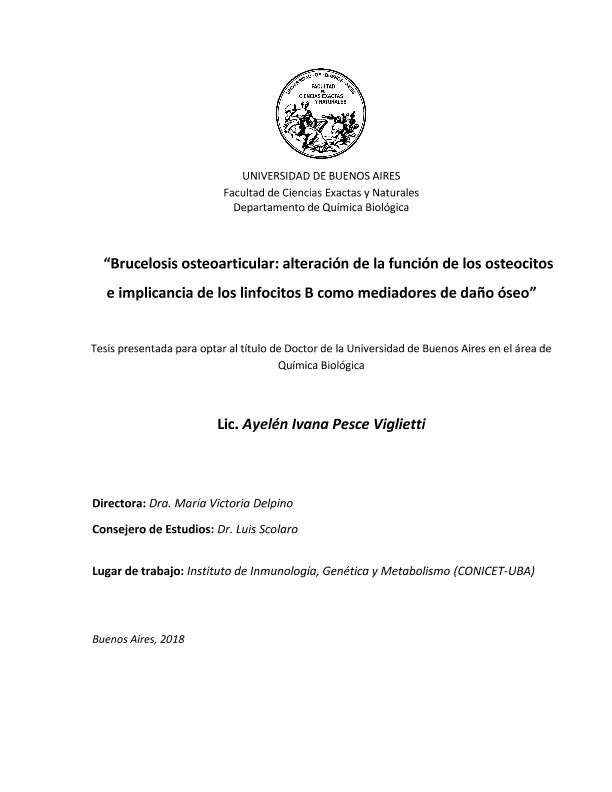Tesis doctoral
La brucelosis osteoarticular es la localización más común de la enfermedad activa en el hombre. Sin embargo, los mecanismos inmunomoleculares implicados no han sido completamente dilucidados. Los resultados obtenidos en esta tesis indican que B. abortus invade y se replica en los osteocitos de la línea murina (MLO-Y4) inhibiendo la expresión de conexina-43, sin afectar su viabilidad e induciendo la secreción de mediadores proinflamatorios, entre los cuales RANKL y TNF-α fueron los principales involucrados en la inducción de osteoclastogénesis. La respuesta de los osteocitos pudo ser modulada por macrófagos infectados, los cuales redujeron la expresión de conexina-43 e indujeron la muerte de los osteocitos por apoptosis. Los osteocitos son la forma totalmente diferenciadas de los osteoblastos (células implicadas en la secreción de matriz ósea). B. abortus fue capaz de invadir y multiplicarse en osteoblastos inhibiendo la secreción de matriz mediante un mecanismo que depende de la activación de la vía autofágica. B. abortus invade pero no se multiplica en los linfocitos B, indicando que constituyen un nicho de persistencia de la bacteria. Nuestros resultados demostraron que los linfocitos B están implicados en el daño óseo al inducir osteoclastogénesis mediante un mecanismo que involucra a RANKL. En conjunto estos resultados indican que B. abortus crea un microambiente proinflamatorio y proosteoclastogénico el cual podría contribuir a la destrucción ósea y articular observada en pacientes con complicaciones osteoarticulares de la brucelosis. Osteoarticular brucellosis is the most common site of active disease in man. However, the immunomolecular mechanisms involved have not been fully elucidated yet. The results obtained in this thesis indicate that B. abortus invades and replicates in the osteocytes of the murine line (MLO-Y4) inhibiting the expression of connexin-43, without affecting its viability and inducing the secretion of proinflammatory mediators, among which RANKL and TNF-α were the main ones involved in the induction of osteoclastogenesis. The response of the osteocytes could be modulated by infected macrophages, which reduced the expression of connexin-43 and induced the death of osteocytes by apoptosis. Osteocytes are the totally differentiated form of osteoblasts (cells involved in the secretion of bone matrix). B. abortus was able to invade and multiply in osteoblasts by inhibiting matrix secretion by a mechanism that depends on the activation of the autophagic pathway. B. abortus invades but does not multiply in B lymphocytes, indicating that they constitute a niche of persistence of the bacterium. Our results demonstrated that B lymphocytes are involved in bone damage by inducing osteoclastogenesis through a mechanism involving RANKL. Overall, these results indicate that B. abortus creates a proinflammatory and pro-osteoclastogenic microenvironment which could contribute to the bone and joint destruction observed in patients with osteoarticular complications of brucellosis.
Brucelosis osteoarticular: alteración de la función de los osteocitos e implicancia de los linfocitos B como mediadores de daño óseo
Pesce Viglietti, Ayelén Ivana

Director:
Delpino, María Victoria

Consejero de estudios:
Scolaro, Luis Alberto

Fecha de publicación:
27/03/2018
Idioma:
Español
Clasificación temática:
Resumen
Palabras clave:
BRUCELLA ABORTUS
,
OSTEOCITOS
,
OSTEOBLASTOS
,
LINFOCITOS B
,
OSTEOCLASTOGENESIS
Archivos asociados
Licencia
Identificadores
Colecciones
Tesis(INIGEM)
Tesis de INSTITUTO DE INMUNOLOGIA, GENETICA Y METABOLISMO
Tesis de INSTITUTO DE INMUNOLOGIA, GENETICA Y METABOLISMO
Citación
Pesce Viglietti, Ayelén Ivana; Delpino, María Victoria; Scolaro, Luis Alberto; Brucelosis osteoarticular: alteración de la función de los osteocitos e implicancia de los linfocitos B como mediadores de daño óseo; 27-3-2018
Compartir



